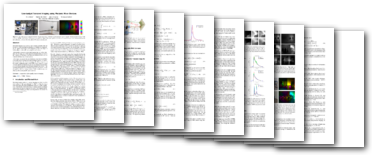 | |||||||||||
Our novel imaging system for capturing "light in flight". Left: Our capture setup for transient images (from left: computer, signal generator, power supply, modulated light source, PMD camera). Middle: A disco ball with many mirrored facets. Right: The same sphere as seen by our transient imager when illuminated from the left, colored according to the time offset of the main intensity peak.|
| Publications
AbstractTransient imaging is a recent imaging modality in which short pulses of light are observed "in flight" as they propagate through a scene. Transient images are useful to help understand light propagation in complex environments and to analyze light transport for research and many practical applications. Two such examples are the reconstruction of occluded geometry, i.e. "looking around a corner", or measuring surface reflectance.Unfortunately, advances in research and practical applications have so far been hindered by the high cost of the required instrumentation, as well as the fragility and difficulty to operate and calibrate devices such as femtosecond lasers and streak cameras. To address this, we present a device that allows inexpensive and fast transient imaging using photonic mixer devices (PMDs). Our portable device achieves this by capturing a sequence of modulated images with a PMD sensor and inferring a transient image using numerical optimization and a mathematical model for local light interactions. By doing so, the cost of transient imaging is reduced by several orders of magnitude and the capture process is dramatically sped up and simplified. We envision that in the future not only research but virtually everybody has access to inexpensive, fast and portable transient-image cameras with its many emerging applications. We consider our device as a large step towards this goal. An in-depth treatment of the idea and theory behind our device will be provided in our technical paper submission associated to this project. |
Problem definition
|
Transient imaging currently relies on very expensive custom hardware, namely a femtosecond laser as a light source, and a streak camera for the image capture. Together these components amount to hundreds of thousands of dollars worth of equipment that is bulky and extremely slow, sensitive and difficult to operate in addition to being a potential eye hazard. Capture times of an hour or more have been reported for a single transient image since the streak camera obtains only a single scanline per exposure and must mechanically scan the scene. To date, such captures have only been performed in lab settings.
In our work, we replace this complex setup with one costing only a few hundred dollars that is straightforward to operate and portable. Our hardware consists of a modified, but simple, photonic mixer device (PMD) sensor in conjunction with inexpensive laser diodes as an illuminant. Using data captured by this hardware, we demonstrate how models for local light interaction can be used to extract transient images. This enables research on the applications of transient imaging on a much smaller budget and in only a few minutes per capture.
|
Code, Data and Video
| Code and Data (418MB): | [LowBudgetTransientImaging_code_and_data.zip] |
| Supplemental material (43MB): | [Supplement_LowBudgetTransientImaging.zip] |
| Technical papers video (92MB): | [LowBudgetTransientImaging.avi] |
